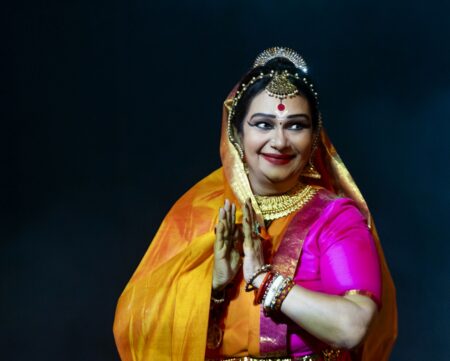The Mayurbhanja Chhau festival in Odisha saw the participation of the largest contingent of female artists this year.
As we boarded the train from Odisha’s capital city of Bhubaneswar for Baripada, the district headquarter town of Mayurbhanj bordering Bengal, we noticed an unusual rush of passengers. “For the people of Mayurbhanj, coming home during Chaitra Parva (spring festival) is a commitment. Our Chhau festival starts tomorrow and we never miss it,” a co-passenger explained to us a little later.
Next evening, as we arrived at the historic and sprawling Chhau Padia (Chhau field) in Baripada town where the one and half a century old annual Chaitra Parva was about to commence, the incredible crowd with a very high degree of enthusiasm convinced us why all roads led to the Chhau Padia for the three evenings. It was the people’s very own festival that celebrated their pride and heritage – the unique and unmasked Mayurbhanja (Mayurbhanj) Chhau dance tradition.
One of the three genres of the martial dance tradition – Saraikela Chhau of Jharkhand and Purulia Chhau of West Bengal being the other two – Mayurbhanja Chhau flourished under the patronage of the royal rulers of the erstwhile princely state of Mayurbhanj that merged into Indian union following Independence.

The palace connection
Invented to boost the spirit of the soldiers as a mock fight and to keep them fit for any fight, Chhau is believed to have derived its nomenclature from chhauni (military camp). Maharaja Krushna Chandra Bhanja Deo, who ruled during the second half of the 19th century, had introduced Chhau to Chaitra Parva which was being hosted inside the king’s palace as the most important annual festival.
The king took a keen interest in grooming the Chhau dancers. He created two troupes – Uttar Sahi and Dakshin Sahi and appointed ustads (experts) to recruit talented artists and train them. The artists were offered the best treatment; so that they could focus fully on their dance practice for the annual festival.
Competition for a cause
To create a healthy competition with the mission to encourage the artists to excel, the queen patronized the Uttar Sahi troupe while the Dakshin Sahi troupe received the patronage of the king.
Under the watchful and caring eyes of their patron-rulers, the artistes would commence their preparations for the festival six months ahead of the event. The choreographies planned for the festival of the year would be a closely guarded secret till the performances would occur on stage.
The king and queen would especially invite their counterparts from other kingdoms to watch the show. The common people would also be allowed to enter the palace – the only occasion during the year – to witness the performances. And the best performers in various categories would be awarded before the end of the festival.
Following independence and upon the abolition of the royal rule, the district administration led by the District Collector hosts this spectacular event that still retains its competitive character.
From the palace to the Padia and the people
After the government took over, the palace festival became the people’s festival. Mayurbhanja Chhau Nrutya Pratisthan, the umbrella organization for Mayurbhanja Chhau, was formed with members from both the troupes of Uttara Sahi and Dakshina Sahi and the District Collector as its head. A sprawling field was named Chhau Padia for the staging of the show.
To encourage Chhau artists spread across the district and tap their talents, the new festival management earmarked the inaugural evening of the three-day festival for a competition among the rural Chhau troupes. The second and third evenings witness competitive presentations by the two traditional rivals of the town – Uttar Sahi and Dakshin Sahi.
Apart from honouring the best troupes, the best male and female actors, promising and emerging artists and accompanying musicians with cash awards, the festival also especially honours eminent Chhau exponents. Padma Shri Sasadhar Acharya, the best-known exponent of Saraikela Chhau today, was honoured this year as a special guest.

Back with a bang
In its history of over 150 years, Baripada’s Chaitra Parva got a break for two years due to Covid restrictions causing immense agony for the people and the artists alike. Thus, excitement was in the air as they were allowed to be back in the Chhau Padia this year. The sound of crackers across the entire town on inaugural day spoke volumes of their intense joy.
The festival this year witnessed the participation of the largest contingent of female artists – literally a victory for the women who were not allowed to perform in the festival till 1993. With nearly 400 artists, 15 troupes and 36 productions, the three-day festival celebrated the strength and beauty of Mayurbhanj Chhau.
The show must go on Billed as “our very own festival” by the people of Mayurbhanj, people from far off places of the district were seen reaching the venue with families and friends to be a part of the dusk-to-dawn event over the three evenings.
As the night grew older, the crowd was soaring higher; thereby indicating the immense mass appeal of the unique martial arts tradition both among the urban and the rural folks. And the presence of all the people’s representatives of the district and the officials of the district administration including the District Collector as the chief host made the annual union a memorable affair for one and all.
Photos courtesy Baripada Photo Studio




